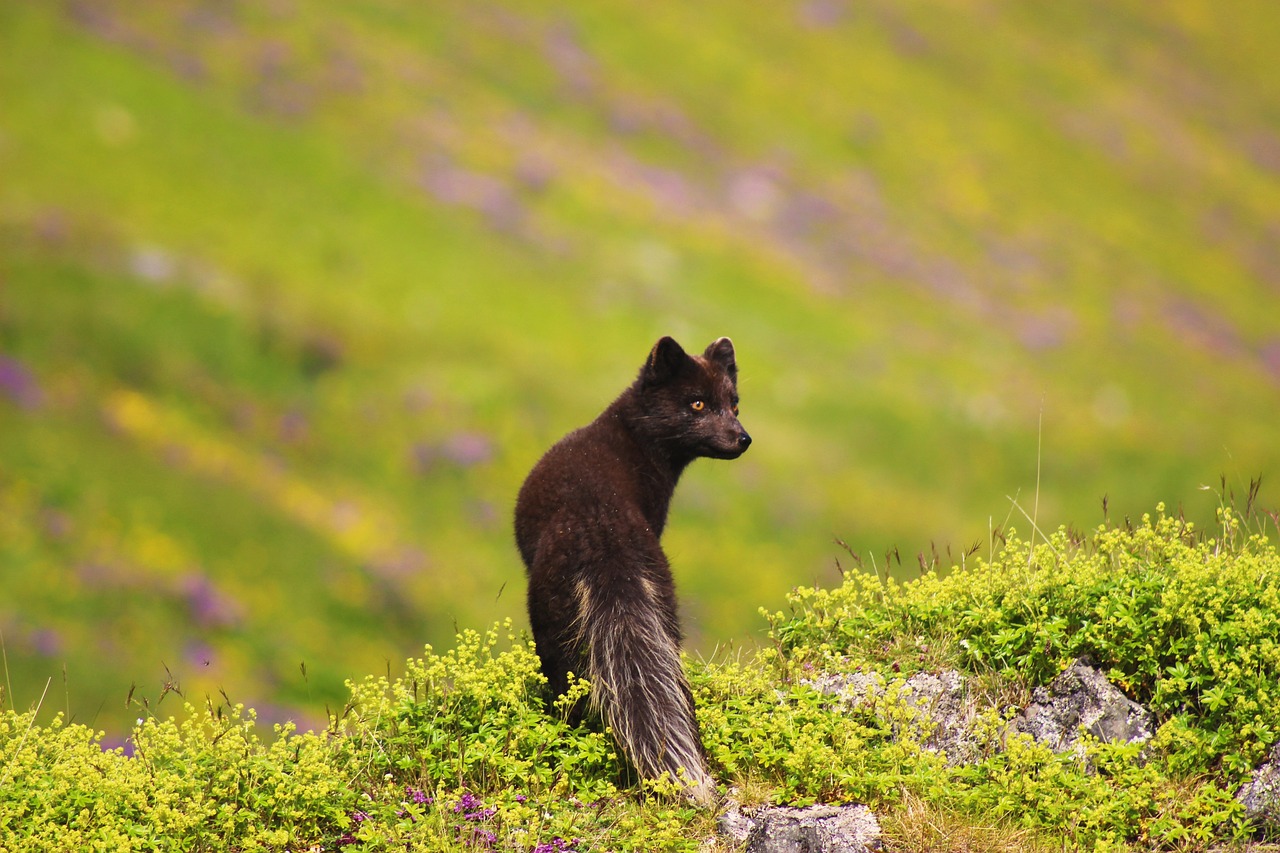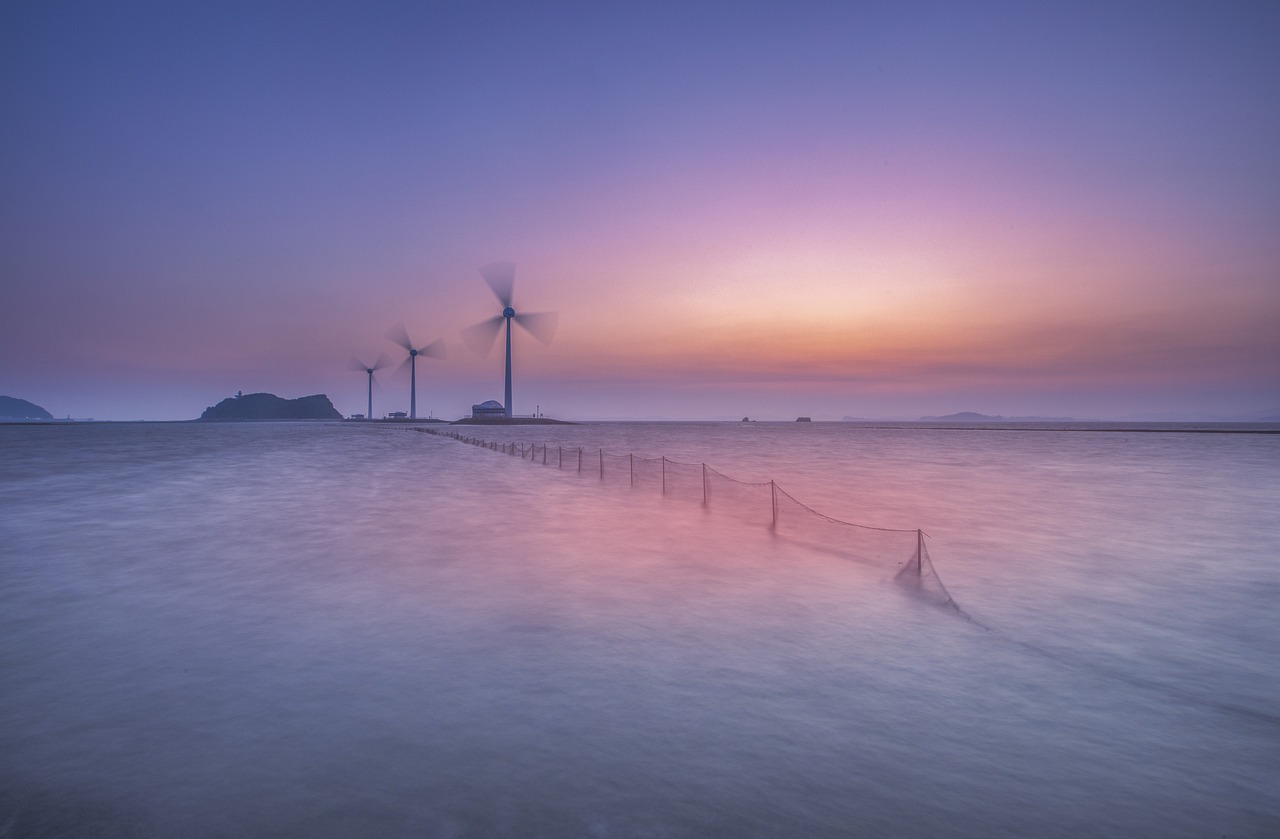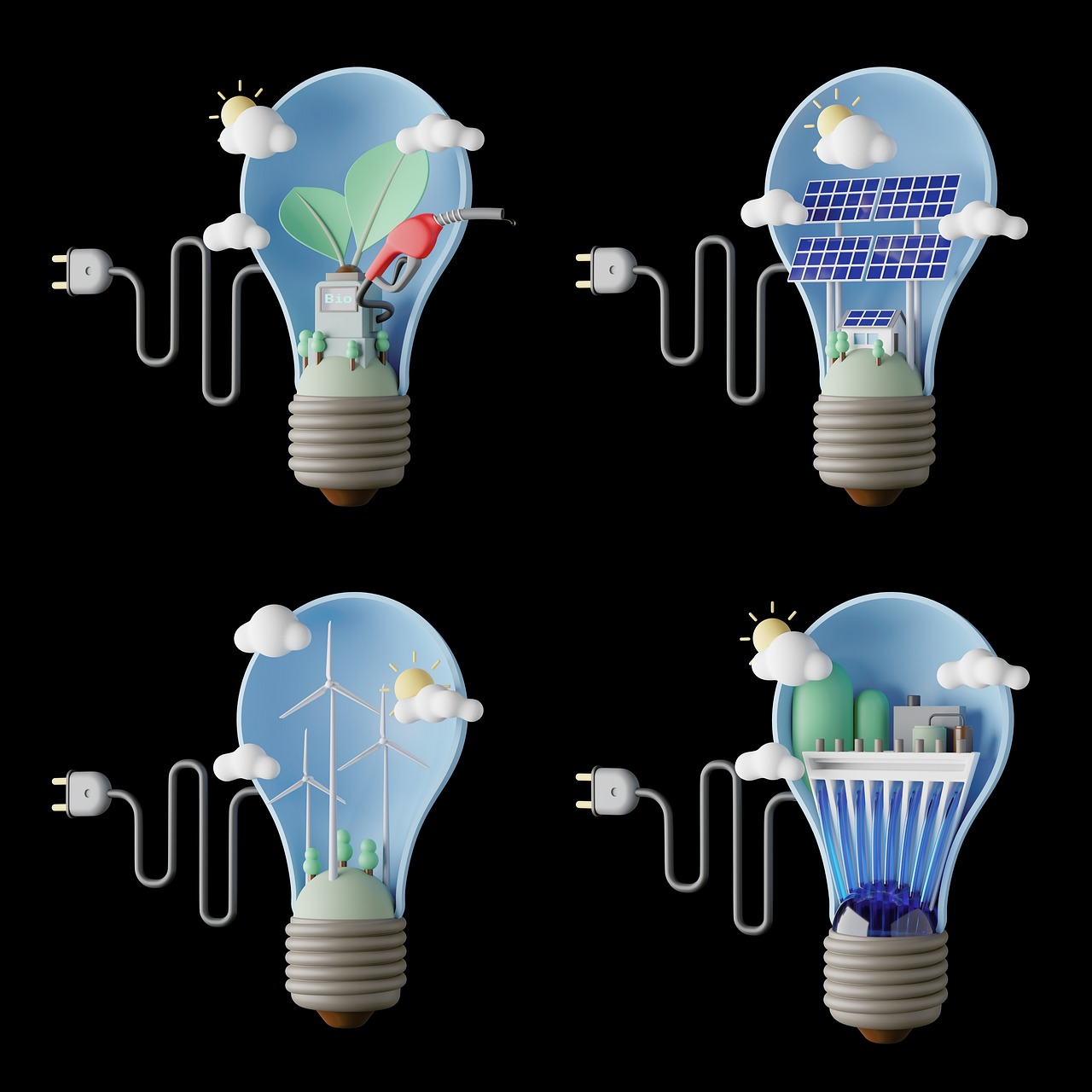Challenges for Green Energy in Arctic Regions
The Arctic is a land of breathtaking beauty and harsh realities, where the sun barely rises in winter, and temperatures can plummet to extreme lows. Amidst this stark environment, the quest for green energy solutions emerges as both a necessity and a challenge. As the world grapples with climate change, the Arctic stands at the forefront of renewable energy discussions. However, the path to implementing sustainable energy sources in this region is fraught with obstacles that are as formidable as the icy landscapes themselves. From environmental hurdles to socio-economic factors, the challenges are numerous and complex, making it essential to explore each aspect thoroughly.
The Arctic's extreme weather patterns present a significant barrier to the efficiency and reliability of green energy technologies. The long winters, characterized by frigid temperatures and relentless storms, can hinder the production of solar and wind energy. For instance, solar panels are less effective when covered in snow, and wind turbines face the risk of ice accumulation, which can impede their functionality. This leads to questions about the viability of these technologies in such a demanding environment. How can we ensure a consistent energy supply when nature itself seems to conspire against us? The answer lies in understanding and adapting our technologies to thrive in these conditions.
Another major hurdle is the infrastructure limitations in remote Arctic regions. The vast distances and sparse population mean that establishing a reliable energy supply chain is no small feat. Roads are often non-existent or impassable, complicating the transport of materials and maintenance of energy systems. This lack of infrastructure not only affects energy production but also makes it challenging to implement necessary upgrades or repairs. Imagine trying to maintain a complex machine in the middle of a snowstorm—it's not just inconvenient; it’s a logistical nightmare.
The financial burden associated with developing green energy projects in the Arctic is substantial. High costs stem from the need for specialized equipment, transportation challenges, and the harsh environment that requires robust solutions. Investors may hesitate to pour funds into projects that seem risky or underdeveloped, which can slow the transition to renewable energy sources. The irony is that while the initial costs are daunting, the long-term benefits of sustainability and reduced reliance on fossil fuels could far outweigh these expenses. It's a classic case of needing to spend money to save money in the future.
As we push for green energy solutions, we must also consider the impact on Indigenous communities. The introduction of renewable energy projects can disrupt traditional lifestyles, leading to concerns about cultural preservation. Indigenous populations often have a deep connection to their land, and any changes to the environment can have profound effects on their way of life. Moreover, there are questions about who benefits from these projects. Are the energy benefits being equitably distributed? We must ensure that Indigenous voices are included in the conversation, fostering a collaborative approach that respects their heritage and needs.
Existing renewable energy technologies may require significant adaptation to operate efficiently in Arctic conditions. This poses challenges for research and development efforts aimed at innovation. For example, the materials used in solar panels and wind turbines might need to be modified to withstand extreme cold and ice. This ongoing need for adaptation can slow progress and increase costs, leading to a frustrating cycle of trial and error. The quest for efficiency in such a unique environment is akin to trying to fit a square peg into a round hole—innovation is crucial, but it takes time and resources.
The delicate Arctic ecosystem is incredibly vulnerable to disturbances. The deployment of green energy projects must be carefully managed to minimize ecological impacts and protect biodiversity. For instance, constructing wind farms or solar fields can disrupt local wildlife habitats. It’s essential to conduct thorough environmental assessments and engage in sustainable practices that prioritize the health of the ecosystem. After all, we can't afford to trade one environmental crisis for another.
Navigating the complex regulatory landscape in Arctic regions can hinder the approval and implementation of green energy initiatives. Different stakeholders, including local governments, Indigenous communities, and international bodies, often have conflicting interests. This necessitates collaboration and open dialogue among all parties involved. Think of it as trying to coordinate a group project in school; without clear communication and shared goals, progress can stall, leaving everyone frustrated.
Effective energy storage is crucial for balancing supply and demand in Arctic regions. However, current technologies may not adequately meet the unique challenges posed by seasonal energy fluctuations. With long periods of darkness in winter and continuous daylight in summer, finding a reliable way to store energy becomes essential. Innovations in battery technology and other storage solutions will be key to ensuring that green energy can be harnessed and utilized efficiently, regardless of the season.
Finally, building public awareness and acceptance of green energy initiatives in Arctic communities is essential for successful implementation. Outreach and education efforts are necessary to foster local support and address any misconceptions about renewable energy. Engaging with the community and showcasing the benefits of green energy can help bridge the gap between skepticism and acceptance. After all, when people understand the advantages, they are more likely to embrace change.
- What are the main challenges of implementing green energy in the Arctic? The main challenges include harsh climate conditions, infrastructure limitations, high costs, and impacts on Indigenous communities.
- How does the Arctic climate affect renewable energy technologies? Extreme weather can hinder the efficiency of solar panels and wind turbines, making energy production unreliable.
- What role do Indigenous communities play in green energy projects? Indigenous communities must be included in discussions to ensure that their rights and cultural heritage are respected.
- Why is energy storage important in the Arctic? Effective energy storage is crucial to balance supply and demand, especially with seasonal energy fluctuations.

Harsh Climate Conditions
When we think of the Arctic, the first things that often come to mind are breathtaking landscapes, shimmering icebergs, and the mesmerizing dance of the Northern Lights. But beneath this stunning facade lies a reality that poses significant challenges for green energy solutions. The Arctic's are not just a minor inconvenience; they are a formidable barrier that can drastically affect the efficiency and reliability of renewable energy technologies.
Imagine trying to harness solar energy in a place where the sun barely rises for months on end. That's the reality in many Arctic regions during winter. The extreme cold, coupled with prolonged darkness, means that solar panels can become almost useless for extended periods. Similarly, wind energy, which might seem promising given the region's strong winds, can also be problematic. Turbines need to withstand not only the intense winds but also the ice accumulation that can hinder their operation. This is not just an engineering challenge; it's a matter of survival for communities that depend on consistent energy sources.
Moreover, the unpredictable weather patterns in the Arctic can lead to sudden storms and temperature fluctuations. These conditions can disrupt energy production and make maintenance of renewable energy systems incredibly difficult. For instance, if a wind turbine fails during a snowstorm, the logistics of sending a repair team to a remote location become daunting. In essence, the Arctic's climate is like a double-edged sword; it offers the potential for renewable energy but simultaneously presents significant operational challenges.
To illustrate the impact of these climatic challenges, consider the following table that summarizes the main renewable energy sources and their vulnerabilities in Arctic conditions:
| Energy Source | Challenges |
|---|---|
| Solar Energy | Limited sunlight during winter months; efficiency drops in extreme cold. |
| Wind Energy | Ice accumulation on turbines; high winds can lead to mechanical failures. |
| Hydro Energy | Frozen water bodies can halt energy production; seasonal fluctuations in water flow. |
In conclusion, while the Arctic holds immense potential for green energy, the present a unique set of challenges that must be addressed. Overcoming these obstacles requires innovative thinking, advanced technology, and a commitment to sustainability. As we push forward into a future that prioritizes renewable energy, we must remember that the Arctic is not just a blank canvas; it is a complex environment that demands respect and careful consideration.
As we navigate these challenges, it’s essential to engage with local communities and understand their needs and perspectives. After all, the ultimate goal is not just to implement green energy solutions, but to do so in a way that enhances the lives of those who call the Arctic home.
- What are the main challenges for green energy in the Arctic? The main challenges include harsh climate conditions, infrastructure limitations, high costs of implementation, and impacts on Indigenous communities.
- How does the Arctic climate affect solar energy production? The Arctic experiences long periods of darkness during winter, which significantly reduces the efficiency of solar panels.
- Why is infrastructure a concern for green energy projects in the Arctic? Many remote areas lack the necessary infrastructure to support renewable energy systems, making it difficult to establish reliable supply chains and maintenance networks.
- What role do Indigenous communities play in green energy projects? Indigenous communities often have traditional lifestyles that can be disrupted by new energy projects, raising concerns about cultural preservation and equitable energy distribution.

Infrastructure Limitations
The Arctic is a breathtaking region, filled with stunning landscapes and unique wildlife, but it also presents some serious that hinder the development and implementation of green energy solutions. Imagine trying to set up a high-tech solar farm in a place where the ground is perpetually frozen and access roads are often covered in snow. The remoteness of many Arctic communities means that they are often cut off from the rest of the world, making it challenging to transport the necessary materials and equipment for renewable energy projects. This is not just a minor inconvenience; it can lead to significant delays and increased costs.
To put it simply, the lack of established infrastructure creates a domino effect that impacts various aspects of green energy deployment. For instance, without proper roads and transportation systems, getting wind turbines or solar panels to remote locations becomes a logistical nightmare. Additionally, maintenance and repair of these systems can be incredibly difficult when the nearest service center is hundreds of miles away. In many cases, the harsh weather conditions can further complicate these challenges, making it hard for technicians to reach sites in need of urgent repairs.
Furthermore, the existing infrastructure in Arctic regions is often not designed to support the kind of renewable energy systems needed for sustainable development. Many communities rely on diesel generators for their energy needs, which are not only costly but also harmful to the environment. Transitioning to renewable sources like wind or solar requires not just the installation of new technology but also upgrades to the electrical grid to accommodate these changes. Unfortunately, the financial and logistical challenges associated with such upgrades can be overwhelming.
In light of these challenges, it's essential to consider innovative solutions that can help overcome infrastructure limitations. For example, modular renewable energy systems that can be easily transported and assembled on-site might be a viable option. Additionally, investing in local workforce training to build capacity for installation and maintenance can empower communities and promote sustainability. However, these solutions require collaboration among governments, private sector players, and local communities to ensure that the necessary resources and support are available.
To summarize, the infrastructure limitations in the Arctic present significant hurdles for green energy initiatives. Addressing these challenges will require a concerted effort to develop tailored solutions that consider the unique conditions of the region. The path to a sustainable future in the Arctic is not straightforward, but with the right strategies and collaboration, it is certainly achievable.
- What are the main challenges of infrastructure in the Arctic?
The main challenges include remote locations, harsh weather conditions, and inadequate roads and transportation systems that complicate the deployment and maintenance of renewable energy projects. - How can communities overcome infrastructure limitations?
Communities can explore modular renewable energy systems, invest in local workforce training, and collaborate with various stakeholders to develop tailored solutions. - Why is upgrading the electrical grid important for renewable energy?
Upgrading the electrical grid is crucial to accommodate new renewable energy sources and ensure a reliable energy supply to local communities.

High Costs of Implementation
The journey toward green energy in the Arctic is not only a noble endeavor but also a **financially daunting** one. The high costs associated with implementing renewable energy projects in these regions can often feel like climbing a steep mountain without the right gear. From the initial investment to ongoing maintenance, the financial burden can be substantial. But why is it so expensive? Let's break it down.
First off, the **logistical challenges** of transporting materials and equipment to remote Arctic locations can significantly inflate costs. Imagine trying to build a wind farm or solar array in an area where the nearest road is hundreds of miles away. The transportation of heavy machinery and installation materials often requires specialized vehicles and routes, which adds to the overall expense. For instance, a typical solar panel installation might cost around $2.50 to $3.50 per watt in more accessible regions, but in the Arctic, those costs can easily double or triple due to transportation and handling challenges.
Moreover, the **harsh climate** conditions in the Arctic necessitate more robust and durable technology, which often comes at a premium. Equipment must be designed to withstand extreme cold, ice, and strong winds. This means that manufacturers need to invest in research and development to create products that can perform reliably under such conditions. Consequently, the price tag for these technologies is higher, which can deter potential investors.
Another significant factor is the **need for specialized labor**. Skilled workers who can operate and maintain renewable energy systems in Arctic conditions are in short supply. The cost of hiring and training personnel who can handle the unique challenges of the Arctic environment can further drive up project expenses. This is akin to trying to find a needle in a haystack—while there may be plenty of workers available, finding those with the right expertise is a different story.
Additionally, the **financing options** for these projects can be limited. Traditional funding sources may view Arctic renewable energy projects as high-risk investments due to the aforementioned challenges. As a result, project developers often face higher interest rates or may struggle to secure funding altogether. This lack of financial support can stall or even halt promising green energy initiatives, leaving communities in the dark.
To illustrate these points, let’s take a look at a comparison table of estimated costs for renewable energy projects in typical locations versus Arctic regions:
| Project Type | Typical Location Cost (per watt) | Arctic Location Cost (per watt) |
|---|---|---|
| Solar Energy | $2.50 - $3.50 | $5.00 - $10.00 |
| Wind Energy | $1.20 - $2.50 | $3.00 - $6.00 |
| Hydro Energy | $3.00 - $5.00 | $6.00 - $12.00 |
As seen in the table, the costs can skyrocket in Arctic regions, making the transition to green energy seem like a distant dream for many communities. It’s clear that without addressing these financial barriers, the path to sustainable energy solutions in the Arctic will remain a challenging one.
In conclusion, while the **potential benefits** of green energy are immense, the high costs of implementation in Arctic regions pose significant hurdles. Addressing these challenges will require innovative financing solutions, collaboration between governments and private sectors, and a commitment to developing technologies that can thrive in one of the world's most extreme environments. Only then can we hope to harness the power of renewable energy in the Arctic and create a sustainable future for its inhabitants.
- What are the main factors contributing to the high costs of green energy projects in the Arctic?
The main factors include logistical challenges, the need for specialized equipment, skilled labor shortages, and limited financing options. - How do Arctic conditions affect renewable energy technologies?
Arctic conditions require technologies that can withstand extreme cold, ice, and high winds, which often results in higher costs for development and maintenance. - Are there any successful green energy projects in the Arctic?
Yes, there are several projects that have successfully implemented renewable energy solutions, but they often face unique challenges that can increase costs.

Impact on Indigenous Communities
The introduction of green energy projects in the Arctic can have profound implications for Indigenous communities, who have lived in harmony with these lands for centuries. While the shift towards renewable energy is crucial for combating climate change, it is essential to consider the cultural, social, and economic impacts that such projects can bring. For many Indigenous peoples, their relationship with the land is not merely a matter of survival; it is intertwined with their identity, traditions, and way of life.
When new energy initiatives are implemented, they often require significant alterations to the landscape, which can disrupt traditional hunting and fishing grounds. Imagine a community that has relied on these resources for generations suddenly finding their access restricted due to new wind farms or solar installations. This disruption can lead to a loss of food security and cultural practices that are vital to their heritage. The question arises: how can we transition to green energy without sacrificing the very cultures that have preserved these unique ecosystems?
Moreover, the economic benefits of green energy projects are not always equitably distributed. Often, outsiders or large corporations reap the financial rewards, leaving Indigenous communities with little to gain. This raises concerns about equitable distribution of resources and benefits. To ensure that Indigenous voices are heard, it is crucial to involve them in the planning and decision-making processes. They should not only be consulted but actively engaged as partners in these projects. This collaboration can lead to more sustainable outcomes, as Indigenous knowledge can provide invaluable insights into local ecosystems.
Furthermore, the potential for job creation in green energy sectors could offer new opportunities for Indigenous peoples. However, these jobs must be accessible and relevant to their skills and traditions. Training programs that incorporate traditional knowledge alongside modern technology can empower Indigenous communities, allowing them to participate meaningfully in the green energy transition.
In summary, while the push for green energy in the Arctic is essential for combating climate change, it is imperative that we approach it with sensitivity and respect for Indigenous communities. Their perspectives, knowledge, and rights must be at the forefront of any initiative. By fostering genuine partnerships and ensuring equitable benefits, we can work towards a future where both renewable energy and Indigenous cultures thrive side by side.
- What are the main concerns of Indigenous communities regarding green energy projects?
Indigenous communities often worry about the disruption of their traditional lifestyles, loss of access to natural resources, and the equitable distribution of benefits from these projects. - How can Indigenous knowledge contribute to green energy initiatives?
Indigenous knowledge can provide crucial insights into local ecosystems, helping to design projects that are more sustainable and less disruptive to the environment. - What role should Indigenous communities play in the planning of green energy projects?
Indigenous communities should be actively involved as partners in the planning and decision-making processes to ensure their rights and interests are respected.

Technological Adaptation
When we think about the Arctic, images of icy landscapes and harsh conditions often come to mind. However, beneath this picturesque surface lies a world of challenges, particularly when it comes to implementing green energy technologies. The Arctic's extreme climate demands that existing renewable energy solutions undergo significant to function effectively. This isn't just a minor tweak; it's akin to asking a fish to climb a tree. While renewable technologies like wind turbines and solar panels have proven effective in milder climates, the Arctic presents a unique set of hurdles that these technologies must overcome.
For instance, consider the issue of wind energy. In the Arctic, winds can be incredibly strong and unpredictable. Traditional wind turbines may not withstand these conditions, leading to potential failures and costly repairs. To address this, engineers are exploring innovative designs that can endure the extreme weather while maximizing energy output. This might include developing turbines that are lower to the ground or those equipped with advanced sensors to adjust their operation based on real-time weather data.
Similarly, solar energy faces its own set of challenges in the Arctic. The long winters mean extended periods of darkness, which significantly reduces solar energy production. However, during the summer months, the sun doesn't set, leading to a surplus of solar energy. To tackle this, researchers are investigating energy storage solutions that can capture and store energy during these brief sunny spells, ensuring a reliable energy supply throughout the year. This is crucial because, without effective storage, the energy generated during the summer could go to waste.
Moreover, the cold temperatures can severely affect battery performance, which is vital for any renewable energy system. Batteries tend to lose efficiency in extreme cold, leading to questions about their viability in Arctic conditions. As a result, there is a pressing need for research and development focused on creating batteries that can operate efficiently in such temperatures. This could involve using advanced materials or designs that are less susceptible to the cold, ensuring that energy storage systems are both reliable and efficient.
In addition to these specific technologies, the broader infrastructure supporting green energy in the Arctic also requires adaptation. This includes everything from the smart grids that distribute energy to the maintenance systems that keep renewable installations operational. The remoteness of many Arctic communities means that traditional supply chains and maintenance networks may not be feasible. Therefore, innovative solutions, such as modular systems that can be easily transported and assembled on-site, are essential for overcoming these logistical challenges.
Ultimately, the path to successful green energy adoption in Arctic regions is paved with the need for continuous innovation and adaptation. As we strive to harness the power of renewable energy in such extreme environments, collaboration among scientists, engineers, and local communities will be vital. Together, they can develop solutions that not only meet the unique demands of the Arctic climate but also respect and integrate with the cultural and ecological landscapes of this fragile region.
- What are the main challenges for green energy technologies in the Arctic? The main challenges include extreme weather conditions, the need for specialized equipment, and the logistical difficulties of maintaining infrastructure in remote areas.
- How can renewable energy projects benefit Arctic communities? Renewable energy projects can provide reliable power, reduce dependence on fossil fuels, and create local jobs, but they must be implemented thoughtfully to respect local cultures.
- What role does technology play in overcoming Arctic energy challenges? Technology is crucial for adapting existing renewable solutions to withstand harsh conditions and for developing new methods of energy storage and distribution.

Environmental Concerns
The Arctic is a treasure trove of natural beauty and biodiversity, but it's also a region that faces intense scrutiny when it comes to environmental sustainability. As we venture into the realm of green energy projects, we must tread carefully, as the delicate Arctic ecosystem is particularly vulnerable to disturbances. Imagine the Arctic as a fragile glass sculpture; one wrong move could lead to cracks that may never heal. The deployment of renewable energy technologies, while noble in intention, can inadvertently disrupt the very ecosystems we aim to protect.
One of the most pressing concerns is the impact of construction and maintenance activities on local wildlife. For instance, the noise and pollution from building wind farms or solar arrays can displace animals from their natural habitats. This is especially critical for species like the polar bear and migratory birds, whose survival depends on specific environmental conditions. Furthermore, the introduction of roads and other infrastructure can lead to increased human-wildlife interactions, often with dire consequences for both.
Additionally, we must consider the potential for oil spills and other environmental accidents. The Arctic's remote location makes it challenging to respond quickly to such incidents. A spill in icy waters could have catastrophic effects, not just on marine life but also on the indigenous communities that rely on these waters for their livelihood. The long-term ecological impacts of such disasters can last for decades, further complicating the balance between energy production and environmental preservation.
Moreover, the issue of climate change cannot be ignored. The Arctic is warming at an alarming rate, leading to rapid changes in the environment. As we introduce new energy technologies, we must also consider their carbon footprints and how they contribute to the very changes we seek to mitigate. It's a paradox that demands our attention: how do we transition to renewable energy without exacerbating the climate crisis? This question underscores the need for rigorous environmental assessments and sustainable practices in all green energy initiatives.
To ensure that green energy projects do not compromise the Arctic's fragile ecosystems, a collaborative approach is essential. This involves not only scientists and engineers but also local communities and indigenous peoples who have lived in harmony with these lands for centuries. Their knowledge and insights can provide invaluable guidance in navigating the complexities of environmental stewardship. By integrating traditional ecological knowledge with modern technology, we can pave the way for a more sustainable future.
In summary, while the push for green energy in the Arctic is crucial for combating climate change, it comes with significant environmental responsibilities. We must prioritize the protection of the unique ecosystems and biodiversity that define this region. As we move forward, a balanced approach that respects both technological advancements and environmental integrity will be key to achieving sustainable energy solutions in the Arctic.
- What are the main environmental concerns associated with green energy projects in the Arctic? The primary concerns include disruption to wildlife habitats, potential oil spills, and the overall impact on the delicate Arctic ecosystem.
- How can indigenous knowledge contribute to sustainable energy practices? Indigenous communities possess valuable insights into local ecosystems and can guide energy projects to minimize environmental impacts.
- What measures can be taken to mitigate the environmental impacts of green energy projects? Conducting thorough environmental assessments, engaging local communities, and implementing sustainable practices are essential steps.

Regulatory Challenges
The Arctic region, with its breathtaking landscapes and unique ecosystems, faces a myriad of when it comes to implementing green energy solutions. One of the primary hurdles is the complex web of regulations that vary not only by country but also by local jurisdictions. This patchwork of laws can create confusion and delays, making it difficult for companies and governments to navigate the approval processes necessary to launch renewable energy projects. Imagine trying to assemble a jigsaw puzzle where the pieces come from multiple boxes—each with its own set of rules and guidelines. That’s what stakeholders in Arctic energy projects often experience.
Additionally, the regulatory framework often lacks coherence, leading to inconsistencies in policy enforcement. For instance, while some regions may offer incentives for green energy development, others may impose stringent restrictions that inhibit progress. This inconsistency can deter potential investors who are unsure of the regulatory environment they will face. Moreover, the need for environmental assessments and consultations with Indigenous communities adds layers of complexity to the regulatory process. These assessments, while crucial for protecting the environment and respecting local cultures, can often extend project timelines significantly.
To illustrate the regulatory landscape, consider the following table that outlines some of the key regulatory challenges faced in the Arctic:
| Regulatory Challenge | Description |
|---|---|
| Complex Approval Processes | The multi-step process for obtaining necessary permits can lead to delays. |
| Inconsistent Policies | Variations in regulations across regions create uncertainty for developers. |
| Environmental Assessments | Mandatory assessments can prolong project timelines and increase costs. |
| Indigenous Consultation | Engaging with Indigenous communities is essential but can complicate approvals. |
Furthermore, the regulatory challenges are compounded by the rapidly changing climate. As the Arctic environment evolves, so too must the regulations that govern energy projects. Policymakers are often playing catch-up, trying to create frameworks that are both effective and flexible enough to adapt to new realities. This dynamic nature of regulation can lead to uncertainty for stakeholders, making it challenging to commit long-term resources to green energy initiatives.
Ultimately, overcoming these regulatory challenges requires collaboration among various stakeholders, including governments, local communities, and environmental organizations. By fostering open dialogue and understanding, it may be possible to create a more streamlined regulatory framework that promotes sustainable energy solutions while respecting the unique characteristics of the Arctic region.
- What are the key regulatory challenges for green energy in the Arctic?
The key challenges include complex approval processes, inconsistent policies, environmental assessments, and the need for Indigenous consultation. - How do environmental assessments impact project timelines?
Environmental assessments are crucial for protecting ecosystems but can prolong project timelines due to the thorough review process required. - Why is collaboration important in overcoming regulatory challenges?
Collaboration helps to align the interests of various stakeholders, leading to a more effective and streamlined regulatory framework.

Energy Storage Solutions
When we think about the challenges of implementing green energy in the Arctic, one critical aspect often comes to mind: . The Arctic is a unique environment, characterized by its extreme weather conditions and seasonal variations in daylight. This makes traditional energy storage methods less effective. Have you ever tried to keep ice cream from melting on a hot day? Imagine doing that with energy! In essence, the energy produced during the long, bright summer days must be stored effectively to be used during the dark, frigid winters.
Currently, many renewable energy sources, like solar and wind, face significant hurdles when it comes to storing energy for later use. Most conventional batteries simply aren't designed to handle the severe temperatures and harsh conditions of the Arctic. This leads to a pressing question: What can be done to develop effective energy storage solutions in such a challenging environment?
One promising avenue of exploration is the use of advanced battery technologies. These include lithium-ion batteries, flow batteries, and even emerging technologies like solid-state batteries. Each of these options presents its own set of advantages and challenges. For instance, lithium-ion batteries are widely used and well-understood but may struggle with efficiency in extreme cold. On the other hand, flow batteries can offer scalability and longevity, but they might require more infrastructure to implement.
Another innovative solution could be the integration of thermal energy storage. This method involves storing energy in the form of heat, which can then be converted back into electricity when needed. Think of it as saving up warmth in a cozy blanket to use during a chilly night. However, the implementation of thermal storage systems requires careful consideration of the local climate and geography, making it a complex task.
Moreover, hydrogen storage is gaining traction as a viable option. By using excess energy to produce hydrogen through electrolysis, communities can store energy in a gaseous form. When the energy is needed, the hydrogen can be converted back into electricity. This method not only provides a means of energy storage but also creates a clean fuel source. However, the technology is still in its infancy and requires significant investment and research.
To illustrate the potential of these energy storage solutions, let's take a look at the following table, which summarizes some of the key technologies and their respective pros and cons:
| Energy Storage Technology | Advantages | Challenges |
|---|---|---|
| Lithium-Ion Batteries | High energy density, established technology | Temperature sensitivity, limited lifespan |
| Flow Batteries | Scalable, long cycle life | Higher initial costs, complex systems |
| Thermal Energy Storage | Utilizes existing infrastructure, cost-effective | Geographically limited, efficiency concerns |
| Hydrogen Storage | Clean fuel source, versatile | Still developing technology, high costs |
In conclusion, finding effective energy storage solutions in Arctic regions is not just a technical challenge; it's a matter of innovation, investment, and understanding the unique environmental conditions. The path forward is filled with potential, but it requires collaboration between scientists, engineers, and local communities to ensure that these technologies are adapted to meet the needs of the Arctic. After all, the goal is not just to create energy but to create a sustainable future that respects both the environment and the people who call the Arctic home.
- What are the main challenges of energy storage in the Arctic? The main challenges include extreme temperatures, seasonal variations, and the need for technology that can withstand harsh conditions.
- Are there any existing energy storage solutions that work well in Arctic conditions? Some technologies, like flow batteries and thermal energy storage, show promise, but they require further adaptation and investment.
- How can communities support the development of energy storage solutions? Communities can engage in discussions with stakeholders, advocate for research funding, and participate in educational initiatives to raise awareness about sustainable energy practices.

Public Awareness and Acceptance
When it comes to implementing green energy solutions in the Arctic, one of the most critical factors is . Imagine trying to plant a seed in frozen ground—without the right conditions, it just won’t grow. Similarly, green energy projects need the support of local communities to thrive. In remote Arctic regions, where traditional lifestyles have been maintained for generations, introducing new technologies can be met with skepticism. Residents often question how these initiatives will impact their daily lives and the environment they cherish.
Many Arctic communities have deep-rooted traditions and a profound connection to their land. Therefore, any green energy project must not only provide tangible benefits but also respect and integrate with local cultures. This is where education and outreach come into play. Local governments, NGOs, and energy companies need to engage with communities through informative workshops and discussions. By sharing knowledge about the advantages of renewable energy—such as reduced reliance on imported fossil fuels and the potential for job creation—these stakeholders can help dispel myths and foster a more positive outlook.
Moreover, it's essential to address the unique concerns of Indigenous populations. For instance, if a wind farm is proposed, residents might worry about how it will affect wildlife migration patterns or their hunting grounds. Acknowledging these concerns and involving community members in the planning process can lead to solutions that satisfy both energy needs and cultural preservation. Effective communication is key here; it’s not just about pushing an agenda but rather about creating a dialogue that values local knowledge and perspectives.
To further illustrate the importance of public acceptance, consider the following table that outlines the potential benefits of green energy projects when community support is achieved:
| Benefit | Description |
|---|---|
| Job Creation | New projects can create local employment opportunities in construction, maintenance, and operation. |
| Energy Independence | Reducing reliance on imported fuels enhances energy security and stability. |
| Environmental Protection | Renewable energy sources contribute to lower emissions and help protect the fragile Arctic ecosystem. |
| Cultural Integration | Projects that respect and incorporate Indigenous knowledge can strengthen community ties and cultural identity. |
Ultimately, building public awareness and acceptance is a two-way street. It requires patience, understanding, and a genuine commitment to addressing the needs and concerns of Arctic communities. As stakeholders work together to educate and inform, they can cultivate a sense of ownership among residents, transforming skepticism into support. This collaborative spirit is vital for the successful implementation of green energy solutions that are not only effective but also culturally sensitive and sustainable.
- What are the main benefits of green energy in Arctic regions? Green energy can provide job opportunities, enhance energy independence, and protect the environment.
- How can communities get involved in green energy projects? Communities can participate through public meetings, educational workshops, and by voicing their concerns and ideas to project developers.
- What challenges do green energy projects face in the Arctic? Challenges include harsh climate conditions, infrastructure limitations, high costs, and the need for public acceptance.
- Why is public acceptance important for green energy initiatives? Without community support, projects may face opposition, delays, or failure, making it essential to engage and educate local populations.
Frequently Asked Questions
- What are the main challenges for implementing green energy in Arctic regions?
The Arctic faces a unique set of challenges for green energy implementation, including harsh climate conditions, inadequate infrastructure, high costs, and the impact on Indigenous communities. These factors complicate the transition to renewable energy sources and require innovative solutions.
- How do harsh climate conditions affect green energy technologies?
Extreme weather and long winters in the Arctic can significantly reduce the efficiency and reliability of green energy technologies. For instance, solar panels may not generate enough energy during the prolonged dark periods, and wind turbines can be affected by ice accumulation.
- Why is infrastructure a critical issue for renewable energy in the Arctic?
Many Arctic regions lack the necessary infrastructure to support renewable energy systems. This includes everything from roads and transportation networks to maintenance facilities. Without proper infrastructure, establishing reliable energy supply chains becomes a daunting task.
- What are the financial implications of green energy projects in the Arctic?
The cost of developing green energy projects in the Arctic can be quite high due to remote locations and harsh conditions. This financial burden often deters potential investors and slows down the transition to sustainable energy sources.
- How do green energy projects impact Indigenous communities?
The introduction of green energy initiatives can disrupt traditional lifestyles of Indigenous populations. There are concerns about cultural preservation and ensuring that energy benefits are distributed equitably among local communities.
- What adaptations are needed for renewable energy technologies in the Arctic?
Existing renewable energy technologies may need significant adaptations to function efficiently in Arctic conditions. This includes modifications to withstand extreme cold, ice, and snow, which poses challenges for research and development efforts.
- What environmental concerns arise with green energy projects in the Arctic?
The delicate Arctic ecosystem is particularly vulnerable to disturbances. Deploying green energy projects must be carefully managed to minimize ecological impacts and protect biodiversity, ensuring that local wildlife and habitats are not adversely affected.
- What are the regulatory challenges for green energy initiatives in the Arctic?
Navigating the complex regulatory landscape can hinder the approval and implementation of green energy projects. Collaboration among various stakeholders, including governments and local communities, is essential to overcome these hurdles.
- Why is energy storage important for Arctic green energy solutions?
Effective energy storage is crucial for balancing supply and demand in Arctic regions, especially given seasonal energy fluctuations. Current storage technologies may not adequately meet these unique challenges, making it a key area for innovation.
- How can public awareness and acceptance of green energy be improved in Arctic communities?
Building public awareness and acceptance is essential for the success of green energy initiatives. Outreach and education efforts are necessary to foster local support and ensure that communities understand the benefits and implications of renewable energy projects.



















